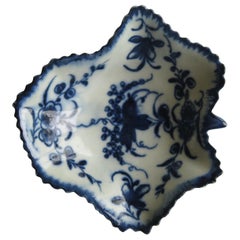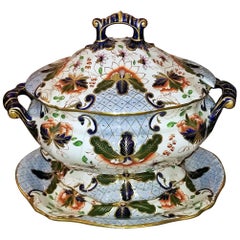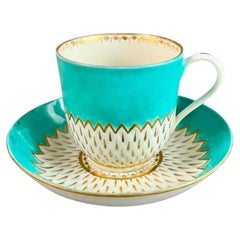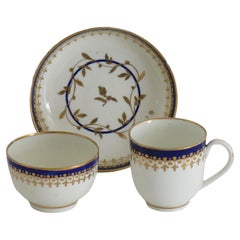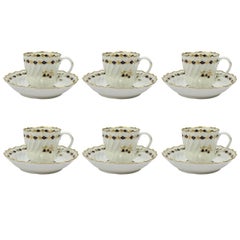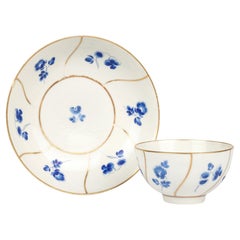George III Porcelain
to
2
113
58
55
387
376
297
238
226
222
195
181
150
138
111
92
92
36
22
8
7
5
113
111
1
1
98
13
110
109
77
2
1
113
113
113
33
9
8
6
5
Style: George III
First Period Worcester Pickle Leaf Dish in Blue Floral Pattern, Ca 1770
Located in Lincoln, Lincolnshire
This is a very good early, First period (Dr. Wall), Worcester porcelain leaf shaped Pickle Dish in a deep cobalt blue floral pattern with a Crescent mark to the base. dating to 1770 ...
Category
18th Century British Antique George III Porcelain
Materials
Porcelain
Amazing Early 19C Davenport Longport Imari China Dinner Service
Located in Dallas, TX
PRESENTING an AMAZING, EXTREMELY RARE and EXTENSIVE Early 19C Davenport Longport Imari China Dinner Service from circa 1805-1820.
HIGH REGENCY PERI...
Category
Early 19th Century English Antique George III Porcelain
Materials
Porcelain
Derby Porcelain Coffee Cup, Artichoke Pattern in Turquoise, Georgian ca 1785
By Derby
Located in London, GB
This is a beautiful coffee cup and saucer made by Derby in about 1785. The set has the distinctive "artichoke" moulding and a bright turquoise ground with the white artichoke surface...
Category
1780s English Antique George III Porcelain
Materials
Porcelain
18th C Worcester Porcelain Trio of Coffee Cup Tea Bowl and Saucer, circa 1780
Located in Lincoln, Lincolnshire
This is a good late 18th century Worcester porcelain TRIO of Coffee Cup, Tea Bowl and Saucer in a combined blue and gold pattern, full...
Category
18th Century British Antique George III Porcelain
Materials
Porcelain
Set of Six 18th Century Flight Worcester Porcelain Tea Cups and Saucers
Located in Philadelphia, PA
A set of six antique Flight Worcester porcelain cups and saucers.
Each with a ribbed swirl design and cobalt blue and gold floral sprig and garland decoration.
Each base is mar...
Category
Late 18th Century Great Britain (UK) Antique George III Porcelain
Materials
Porcelain
Worcester Antique Dry Blue Floral Pattern Teabowl and Saucer
Located in Bishop's Stortford, Hertfordshire
A fine and scarce early English porcelain tea bowl and saucer painted with dry blue floral patterning by acclaimed makers Worcester and dating to the Dr Wall period 1770 – 75. The te...
Category
1770s British Antique George III Porcelain
Materials
Porcelain
Early 19th Century Plate Porcelain Finely Hand Painted, Staffordshire UK Ca 1825
Located in Lincoln, Lincolnshire
This is an early 19th century porcelain Plate or desert dish with a molded wavy edge to the rim, made by one of the quality Staffordshire, English potteries and dating from the George 111rd period, circa 1820 to 1830.
This piece is unmarked to the base but it is very well hand painted and we believe it is from one of the high quality English makers such as Coalport, Davenport or Samuel Alcock.
Either way this piece is a beautifully hand decorated with a striking, bold and very colourful pattern.
Overall a beautifully hand painted early English porcelain...
Category
Early 19th Century English Antique George III Porcelain
Materials
Porcelain
Georgian Spode Coffee Can Porcelain hand decorated & marked SPODE, circa 1810
By Spode
Located in Lincoln, Lincolnshire
This is a very good quality porcelain coffee can by Spode of Staffordshire, England, made during the very early 19th century, George 111rd period, circa 1805.
The coffee can is no...
Category
Early 19th Century English Antique George III Porcelain
Materials
Porcelain
Georgian Coalport Porcelain Coffee Can Hand Gilded Pattern, English circa 1807
Located in Lincoln, Lincolnshire
This is a good quality coffee can that we attribute to the Coalport Porcelain works, Shropshire, England, made during the John Rose period of the George 111rd years, circa 1805-1810.
The coffee can is nominally parallel, tapering slightly to the base, with a simple loop handle with one lower kink and pointed attachments. It has a shallow foot recess with obtuse corner and is unmarked to the base.
The pattern is beautifully hand painted in an all gold gilt floral upper border pattern with further gilding on the body above the base rim, around the upper rim and to the outer handle.
We date this piece to the late George third...
Category
Early 19th Century English Antique George III Porcelain
Materials
Porcelain
Georgian Derby Coffee Can in hand painted pattern 165, circa 1815
Located in Lincoln, Lincolnshire
This is an exquisite Porcelain Coffee can made by the Derby factory, in the reign of George 111 in the early 19th Century, circa 1815
.
Straight sided coffee cans were only made for ...
Category
19th Century British Antique George III Porcelain
Materials
Porcelain
Spode Three Georgian Imari Pattern 967 Decorated Porcelain Plates
By Spode
Located in Bishop's Stortford, Hertfordshire
A very fine set of three Georgian Imari pattern decorated porcelain cabinet plates by Spode and dating from around 1810. The small side plates are of...
Category
1810s English Antique George III Porcelain
Materials
Porcelain
Worcester Coffee Cup, Monochrome Black Print "Tea Party no.3", Georgian ca 1760
Located in London, GB
This is a very charming coffee cup and saucer made by Worcester in their First Period (sometimes called the Dr Wall Period) in about 1760. The items are decorated in a black overglaz...
Category
1760s English Antique George III Porcelain
Materials
Porcelain
Coalport Coffee Can Porcelain Hand Painted Cornflowers Pattern, circa 1805
Located in Lincoln, Lincolnshire
This is a good quality coffee can that we attribute to the Coalport porcelain works, Shropshire, England, made during the John Rose period of the George 111rd years, circa 1805.
The coffee can is nominally parallel, tapering slightly to the base, with a simple loop handle, with a slight lower kink and pointed attachments. It has a shallow foot recess with obtuse corner and is unmarked to the base.
The pattern is beautifully hand painted in the French Chantilly style with cornflower sprigs in gold gilt and blue with red & green leaf detail to the lower half with an upper border continuous cornflower pattern, all between gold gilt rings with further gilt decoration to the outer handle and gilding around the lower rim.
We date this piece to the late George third...
Category
Early 19th Century English Antique George III Porcelain
Materials
Porcelain
Fine Georgian Coalport Desert Plate Richly Gilded Hand Painted Ptn 1949, Ca 1810
Located in Lincoln, Lincolnshire
This is a fine example of an English George III period, Coalport Desert Plate, hand painted in pattern 1949 and dating from the early 19th century, circa 1810.
The Plate is well pot...
Category
Early 19th Century English Antique George III Porcelain
Materials
Porcelain
Derby Porcelain Part Dessert Service, Red Botanical, John Brewer, 1795-1800
By Crown Derby, John Brewer
Located in London, GB
This is a stunning part-dessert service made by Derby between about 1795 and 1800, painted with named botanical studies by John Brewer. The service consists of a lidded sauce comport on a stand, two kidney shaped dishes, two lozenge shaped dishes, one lozenge shaped low footed comport...
Category
1790s English Antique George III Porcelain
Materials
Porcelain
First Period Dr. Wall Worcester Porcelain Teapot Stand Fisherman Ptn, Circa 1775
Located in Lincoln, Lincolnshire
This is a very good 18th century, First period (Dr. Wall), Worcester porcelain teapot stand, printed in cobalt blue with the "Fisherman" pattern and with a mock oriental or painters ...
Category
18th Century British Antique George III Porcelain
Materials
Porcelain
Antique 19th Century Spode English Porcelain Pink Ducks Pattern Desert Plate
By Spode
Located in Philadelphia, PA
A fine antique English porcelain desert plate.
By Spode.
In the "Pink Ducks" pattern.
Depicting a chinoiserie scene of two mandarin d...
Category
19th Century English Antique George III Porcelain
Materials
Porcelain
A Fine Swansea London decorated Porcelain Dish, c1820
Located in Tunbridge Wells, GB
A Fine Swansea London decorated Porcelain Dish, c1820
Additional information:
Date : Circa 1820
Period : George III /George IV
Marks :Stencilled in red upper case 'Swansea' and a fa...
Category
19th Century English Antique George III Porcelain
Materials
Porcelain
Worcester Barr Period Porcelain Coffee Cup in Royal Lily pattern, circa 1800
Located in Lincoln, Lincolnshire
This is a very good hard paste porcelain early Coffee Can or cup with a loop handle, hand decorated in the Royal Lily pattern by Worcester during the Barr p...
Category
Late 18th Century English Antique George III Porcelain
Materials
Porcelain
Chelsea-Derby Vase and Cover, Zachariah Boreman and Richard Askew, 1783-1784
Located in London, GB
This is a very rare and stunning vase with cover made by Chelsea-Derby in 1783-1784. The pear-shaped vase stands on a square foot and has two handles with moulded floral chains, and ...
Category
1780s English Antique George III Porcelain
Materials
Porcelain
Coalport Trio Porcelain Hand Painted Gilded Bold Imari Pattern, circa 1815
Located in Lincoln, Lincolnshire
This is a very good quality TRIO of Coffee Cup, Tea Cup and Saucer that we attribute to the Coalport porcelain works, Shropshire, England, made during the George 111rd years, circa 1815.
Both cups have the London or Grecian shape with all pieces beautifully boldly hand decorated in a very colourful Imari Chinoiserie pattern, popular at the time. All pieces are unmarked to the base.
The pattern is beautifully hand painted in bold colors of burnt orange, green and cobalt blue, all in different shades with an "Imari" style floral pattern, all enhanced with gilded detail to the pattern, upper rim and outer handle.
Both cups also have an inner rim border pattern.
We date this set to the late George third...
Category
Early 19th Century English Antique George III Porcelain
Materials
Porcelain
Dr Wall First Period Worcester Sugar Box 18th Century Circa 1775
Located in Katonah, NY
This is a hand-painted First-Period Worcester Porcelain sugar box from the 18th century.
The lively floral design is painted in green, blue, purple, and gilt.
We see purple stems and...
Category
Late 18th Century Antique George III Porcelain
Materials
Porcelain
New Hall Porcelain Tea Service, Japanese Tobacco Pattern, Georgian, circa 1795
By New Hall
Located in London, GB
This is a stunning tea service made by New Hall in circa 1795. The service is made of hybrid hard paste porcelain and decorated in a bold Chinoiserie pattern of large flower sprays. The service consists of a teapot with cover, a milk jug, a slop bowl, and six tea bowls with saucers.
This service has provenance; it came from the collection of David Redstone, the well known porcelain expert who wrote leading books on Bow and Chelsea porcelain.
The New Hall factory started as a cooperative of several Staffordshire potters making use of the porcelain license of Bristol Porcelain...
Category
1790s English Antique George III Porcelain
Materials
Porcelain
Georgian Spode Desert Plate or Dish Porcelain in Dolls House Prn 488, Ca 1807
By Spode
Located in Lincoln, Lincolnshire
This is a good early English Spode porcelain plate or dish hand painted in the Doll's House pattern, Number 488 and dating to the George 111rd period, very early in the 19th century, circa 1805 to 1810.
The plate is well potted and raised on a low foot. It is well hand painted in burnt orange and cobalt blue enamels in the Doll's House Pattern, No. 488, recorded in 1804. The plate also has a continuous hand painted border pattern to the rim.
This pattern is illustrated on a Spode meat dish...
Category
Early 19th Century English Antique George III Porcelain
Materials
Porcelain
First Period Worcester Porcelain "Pine Cone" Pattern Dishes- A Pair
Located in Downingtown, PA
First Period Worcester Porcelain Pine Cone Pattern Dishes,
A Pair,
Circa 1770
These rectangular dishes are a quintessential example of First Period Worcester porcelain, dating from ...
Category
1770s English Antique George III Porcelain
Materials
Porcelain
Antique 18th Century Worcester Porcelain Black Chinoiserie Bowl or Basin
Located in Philadelphia, PA
A fine antique English porcelain bowl or basin.
Attributed to Worcester.
Decorated throughout with grey and black floral Chinoserie decoration with gilt highlights.
With a ...
Category
18th Century English Antique George III Porcelain
Materials
Porcelain
Flight Worcester Teapot Set, Monochrome Print "Ruins" Pattern, Georgian ca 1790
Located in London, GB
This is a beautiful set of a teapot, a sucrier with cover, and a plate made by Worcester in its Flight period, around 1790. You can tell from the generous size of the teapot that it ...
Category
1790s English Antique George III Porcelain
Materials
Porcelain
Worcester Milk Jug and Cover, Creamer, Monochrome Print Tea Party no.2, ca 1760
Located in London, GB
This is a very charming milk jug with cover made by Worcester in their First Period (sometimes called the Dr Wall Period) in about 1760. The items are decorated in a black overglaze ...
Category
1760s English Antique George III Porcelain
Materials
Porcelain
Derby Porcelain Botanical Comport Pattern 216 c1795
By Derby
Located in Tunbridge Wells, GB
Heading : Derby Porcelain botanical comport pattern 216
Date : c1795
Period : George III
Marks :Double China Hollyhock above Derby Crown and Crossed Swords and pattern number 216
Ori...
Category
1790s British Antique George III Porcelain
Materials
Porcelain
$1,468 / item
Worcester Porcelain Teapot Chinese Figural Decoration
Located in Tunbridge Wells, GB
Heading : Worcester porcelain teapot with Chinese figural decoration
Date : c1770
Period : George III
Marks : None
Origin : Worcester, England
Colour : Polychrome
Pattern : Chinese f...
Category
1770s British Antique George III Porcelain
Materials
Porcelain
Georgian Derby Coffee Can & Saucer John Stanesby hand painted roses, Circa 1810
Located in Lincoln, Lincolnshire
This is a beautiful porcelain coffee can and matching saucer by the Derby factory, made during the late Georgian period of the early years of the 19th Century
The cylindrical can ...
Category
Early 19th Century British Antique George III Porcelain
Materials
Porcelain
Liverpool Porcelain Richard Chaffers and Co Quart Tankard
By Seth Pennington Liverpool Porcelain
Located in Tunbridge Wells, GB
Heading : A Liverpool Porcelain quart tankard / mug
Date : 1760-1765
Period : George11 / George111
Marks :none
Origin :Richard Chaffers. Shaw’s Brow. Liverpool. England
Colour :Blue ...
Category
1760s British Antique George III Porcelain
Materials
Porcelain
Very Large Worcester Porcelain Blue Scale Leaf Dish c1775
Located in Tunbridge Wells, GB
Heading : Worcester blue scale leaf dish
Date : c1775
Period : George III
Marks : Worcester pseudo fret square
Origin : Worcester, England
Colou...
Category
1770s British Antique George III Porcelain
Materials
Porcelain
Spode Porcelain Tea Cup in Hand Painted & Gilded Pattern 967, circa 1810
By Spode
Located in Lincoln, Lincolnshire
This is a fine example of an English George III period, porcelain Tea Cup, made by Spode and hand painted in Pattern 967, during the early 19th century, circa 1815.
The cup has th...
Category
Early 19th Century English Antique George III Porcelain
Materials
Porcelain
Swansea Porcelain Fluted Breakfast Cup and Saucer, c1816
Located in Tunbridge Wells, GB
Swansea Porcelain Fluted Breakfast Cup and Saucer, c1816
Additional information:
Date : c1816
Period : George III
Marks : None
Origin : Swansea, Wales
C...
Category
19th Century English Antique George III Porcelain
Materials
Porcelain
A London Decorated Swansea Porcelain Plate of Burdett Coutts Type, 1815-17
Located in Tunbridge Wells, GB
A London Decorated Swansea Porcelain Plate of Burdett Coutts Type, 1815-17
Additional information:
Date : 1815-1817
Period : George III
Marks : Impressed mark Swansea
Origin : Swans...
Category
19th Century English Antique George III Porcelain
Materials
Porcelain
Swansea Porcelain Dessert Plate By Henry Morris, c1816
Located in Tunbridge Wells, GB
Swansea Porcelain Dessert Plate By Henry Morris, c1816
Additional information:
Date : 1815-1817
Period : George III
Marks : Faint impressed trident mark
Origin : Swansea, South Wale...
Category
19th Century English Antique George III Porcelain
Materials
Porcelain
Georgian Derby Coffee Can Chantilly Sprigs gilded Pattern 129, circa 1810
Located in Lincoln, Lincolnshire
This is a good porcelain Coffee Can or cup hand painted and gilded in pattern 129, made by the Derby factory, in the reign of George 111 in the early 19...
Category
Early 19th Century English Antique George III Porcelain
Materials
Porcelain
Thomas Wolfe Factory Z Lion Pattern English Teacup and Saucer
Located in Bishop's Stortford, Hertfordshire
A scarce antique English Staffordshire bone china teacup and saucer hand decorated with a red lion by Thomas Wolfe (Factory Z) and dating from...
Category
1810s English Antique George III Porcelain
Materials
Porcelain
Early 19th Century Spode Porcelain Slop Bowl in Japan Ptn 1946, circa 1810
By Josiah Spode
Located in Lincoln, Lincolnshire
This is a very good rare example of an English George III period, porcelain, slop bowl, made by Spode in the early 19th century, circa 1810.
The bowl is well potted on a low everted...
Category
Early 19th Century English Antique George III Porcelain
Materials
Porcelain
Rare Georgian Porcelain Coffee Can by Machin & Baggaley Ptn 262, Circa 1810
By Machin and Baggaley
Located in Lincoln, Lincolnshire
This is an early 19th century porcelain coffee can or cup that we attribute to Machin and Baggaley (or Machin & Co.) of Burslem, Staffordshire, England.
Early Machin porcelain pieces tend to be rare.
This coffee can is nominally straight sided and has a good ring handle with a long pointed lower support. It is beautifully hand decorated with a striking floral design having large pink flowers...
Category
Early 19th Century English Antique George III Porcelain
Materials
Porcelain
Swansea Porcelain Dessert Plate By Henry Morris, c1816
Located in Tunbridge Wells, GB
22121707 Swansea Porcelain Dessert Plate By Henry Morris, c1816
Additional information:
Date : 1815-1817
Period : George III
Marks : none
Origin : Swansea, South Wales
Colour : poly...
Category
19th Century English Antique George III Porcelain
Materials
Porcelain
Derby Porcelain Georgian Rare Hand Painted Dish
By Derby
Located in Bishop's Stortford, Hertfordshire
A rare and unusual Georgian Derby Porcelain dish finely hand painted colored enamels dating from around 1790. The oval shaped dish has a raised scalloped rim and is hand painted with...
Category
1790s English Antique George III Porcelain
Materials
Porcelain
Georgian Derby Cup and Saucer Duo in Pattern 561, Puce Mark Circa 1800
By Derby
Located in Lincoln, Lincolnshire
This is a good porcelain duo of a cup and saucer by the Derby factory, made during the George 111rd period, circa 1800.
Both pieces are well potted in the Hamilton flute shape wit...
Category
Early 19th Century British Antique George III Porcelain
Materials
Porcelain
Georgian Derby Coffee Can Hand Painted Roses by John Stanesby, Circa 1810
Located in Lincoln, Lincolnshire
This is a beautiful porcelain Coffee Can by the Derby factory, made during the late Georgian period of the early years of the 19th Century
The cylindrical can tapers slightly to the...
Category
Early 19th Century British Antique George III Porcelain
Materials
Porcelain
Georgian Worcester BF&B Porcelain Coffee Can in Hand Gilded Pattern, circa 1810
Located in Lincoln, Lincolnshire
This is a very good quality coffee can in a hand gilded pattern made by Worcester during the Barr, Flight & Barr period (BFB) of George 111rd years, circa 1807-1813.
The coffee ca...
Category
Early 19th Century English Antique George III Porcelain
Materials
Porcelain
Georgian Derby Trio Tea & Coffee Cup & Saucer Pattern 569, Puce Mark Circa 1795
By Derby
Located in Lincoln, Lincolnshire
This is a good porcelain TRIO of a Tea Cup, Coffee Cup and saucer by the Derby factory, made during the George 111rd period, circa 1795.
The pieces are well potted in the Hamilton...
Category
Late 18th Century British Antique George III Porcelain
Materials
Porcelain
Georgian Derby Coffee Can Hand Painted & fully marked, ca. 1810
Located in Lincoln, Lincolnshire
This is a beautiful porcelain Coffee Can by the Derby factory, made during the late Georgian period of the early years of the 19th Century
The cylindrical can tapers slightly to the...
Category
Early 19th Century British Antique George III Porcelain
Materials
Porcelain
Georgian Worcester Barr Period Coffee Can Porcelain Hand Painted, circa 1800
Located in Lincoln, Lincolnshire
A very good Porcelain Coffee Can with a ring handle, hand decorated with an orange and gilt pattern by Worcester during the Barr period, fully marked to...
Category
Late 18th Century English Antique George III Porcelain
Materials
Porcelain
George 111 Minton Porcelain Coffee Can Hand Painted in Pattern 791, Ca 1805
By Minton
Located in Lincoln, Lincolnshire
This is a finely painted porcelain coffee can made by the Minton factory, England, in the reign of George 111 in the early 19th century, circa 1805
Straight sided coffee cans wer...
Category
Early 19th Century English Antique George III Porcelain
Materials
Porcelain
Caughley Porcelain Teapot, Pink Floral Compagnie des Indes, ca 1785
Located in London, GB
This is a beautiful teapot made by Caughley around 1785, decorated with the "Compagnie des Indes" pattern with bold pink flower sprays and a pink s...
Category
1780s English Antique George III Porcelain
Materials
Porcelain
Early Derby Porcelain Cup & Saucer Rare Pattern 128 Puce Crown Marks, circa 1795
Located in Lincoln, Lincolnshire
This is a late 18th century porcelain Tea Cup and Saucer in pattern 128 by the Derby factory, Circa 1795.
This is a rare Derby pattern that we have not come across or seen previou...
Category
Late 18th Century English Antique George III Porcelain
Materials
Porcelain
SPODE Porcelain Lidded Sucrier Hand Painted and Gilded Pattern 967, Ca 1810
By Spode
Located in Lincoln, Lincolnshire
This is a fine example of an English George III period, porcelain, Sucrier with cover or lidded sugar bowl, made by SPODE all hand painted in Pattern 967, during the early 19th Century, circa 1810.
This Sucrier has a beautiful and elegant shape with high loop handles either side of the oval body. The cover has a shaped oval knob...
Category
Early 19th Century English Antique George III Porcelain
Materials
Porcelain
Georgian Derby Cup and Saucer Duo Hand Painted, Circa 1810
Located in Lincoln, Lincolnshire
This is a beautiful porcelain duo of a cup and saucer by the Derby factory, made during the George 111rd period of the first half of the 19th century, circa 1810
The hand decorati...
Category
Early 19th Century British Antique George III Porcelain
Materials
Porcelain
Antique French or German Porcelain Snuff Box with Hand-Painted Military Scenes
Located in Philadelphia, PA
A fine antique French or German porcelain snuff box.
Dating to the 18th (or possibly early 19th) century.
Decorated throughout with...
Category
18th Century German Antique George III Porcelain
Materials
Porcelain
John Rose Coalport TRIO Porcelain Gilded Royal Garter Pattern, Circa 1800
Located in Lincoln, Lincolnshire
This is an early porcelain trio comprising a coffee can, tea cup and saucer, all in gilded patterns, which we attribute to Coalport, John Rose & Co., Shropshire, England, made at the...
Category
Late 18th Century English Antique George III Porcelain
Materials
Porcelain
Swansea Welsh Pair Famille Rose Chinese Mandarin Pattern Porcelain Cups
Located in Bishop's Stortford, Hertfordshire
A rare and early pair Swansea, Welsh, hand painted porcelain breakfast cups hand painted in the Chinese famille rose style with the Mandarin pattern d...
Category
1810s Welsh Antique George III Porcelain
Materials
Porcelain
Early 19th Century Spode Porcelain Coffee Can Greek Key Pattern 742, circa 1810
By Josiah Spode
Located in Lincoln, Lincolnshire
This is a very good example of an English George III period, porcelain, coffee can, made by Spode in the early 19th century, circa 1810.
The can is nominally straight sided and ha...
Category
Early 19th Century English Antique George III Porcelain
Materials
Porcelain
George 111 Early Minton Porcelain Coffee Can Hand Painted Pattern 76, Ca 1805
By Minton
Located in Lincoln, Lincolnshire
This is a finely painted porcelain coffee can made by the Minton factory, England, in the reign of George 111 in the early 19th century, circa 1805
Straight sided coffee cans were only originally made for about the first 20 years of the 19th century and are very collectable.
The porcelain can is well potted with a ring handle.
It is finely hand decorated in Minton's recorded Pattern Number 76, having three sets of horizontally painted...
Category
Early 19th Century English Antique George III Porcelain
Materials
Porcelain
Worcester Barr Flight & Barr Period Porcelain Tea Cup & Saucer Duo, circa 1810
Located in Lincoln, Lincolnshire
This is a a good early tea cup and saucer duo, hand decorated with a leaf and gilt intertwining pattern by Worcester during the Barr / Barr, Flight and Barr period, fully marked to ...
Category
Early 19th Century English Antique George III Porcelain
Materials
Porcelain
George Iii porcelain for sale on 1stDibs.
Find a broad range of unique George III porcelain for sale on 1stDibs. Many of these items were first offered in the 19th Century, but contemporary artisans have continued to produce works inspired by this style. If you’re looking to add vintage porcelain created in this style to your space, the works available on 1stDibs include serveware, ceramics, silver and glass, decorative objects and other home furnishings, frequently crafted with ceramic, porcelain and other materials. If you’re shopping for used George III porcelain made in a specific country, there are Europe, United Kingdom, and England pieces for sale on 1stDibs. While there are many designers and brands associated with original porcelain, popular names associated with this style include Royal Crown Derby Porcelain, Swansea Porcelain, Coalport Porcelain, and Derby. It’s true that these talented designers have at times inspired knockoffs, but our experienced specialists have partnered with only top vetted sellers to offer authentic pieces that come with a buyer protection guarantee. Prices for porcelain differ depending upon multiple factors, including designer, materials, construction methods, condition and provenance. On 1stDibs, the price for these items starts at $223 and tops out at $54,000 while the average work can sell for $631.
Recently Viewed
View AllMore Ways To Browse
Japanese Coffee Pot
Klemm Dresden
Kpm Berlin Vase
Lagardo Tackett Schmid
Large Breakfast Cup And Saucer
Large Tea Cup
Limoges Dinnerware
Limoges T
Medusa Versace Glass
Meissen Hentschel
Meissen Jug
Minton Coffee
Minton Cup And Saucer
Nantgarw China
Pierced Porcelain Plates
Pink And White Antique China
Pink Minton
Porcelain Slipper
